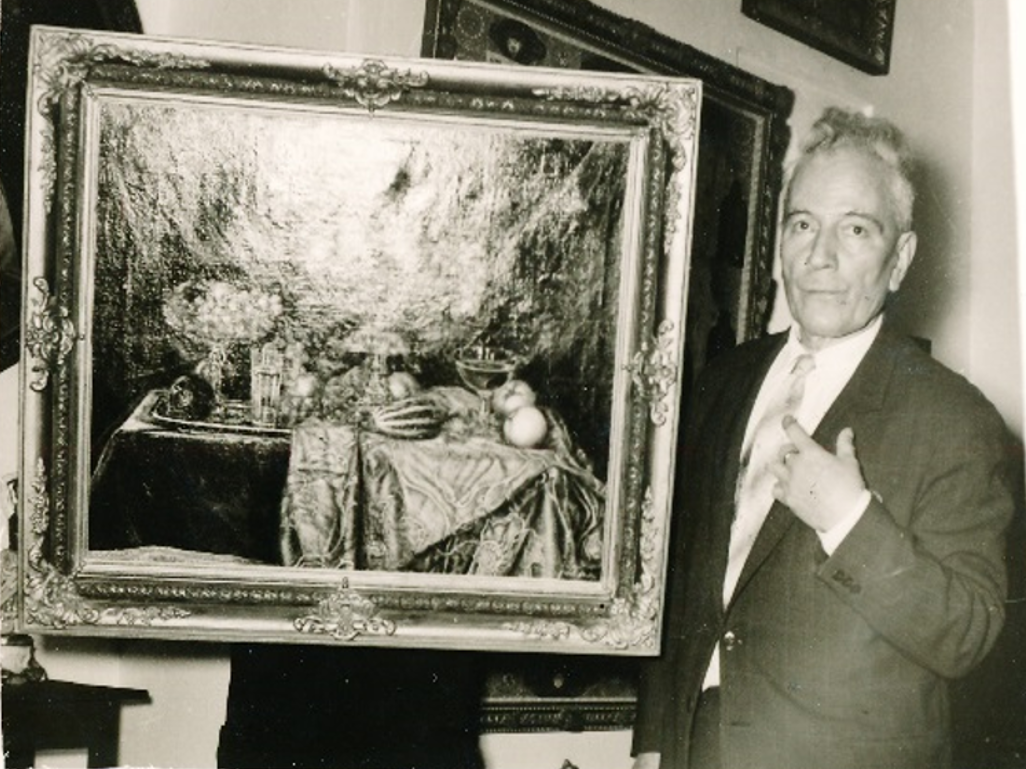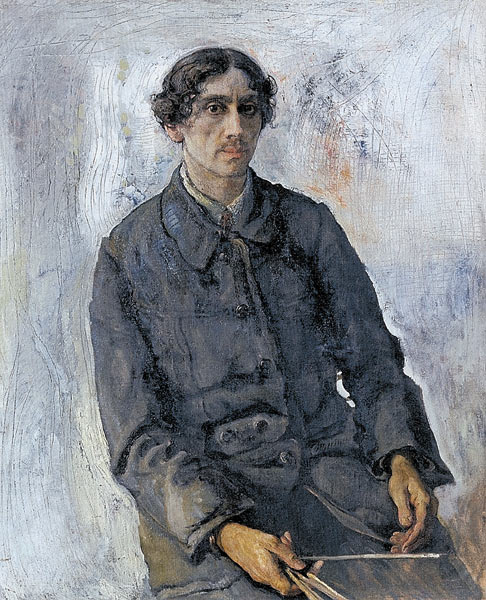|
Dmitry Kardovsky
Dmitry Nicolajevich Kardovsky (Russian: Дмитрий Николаевич Кардовский; 5 September 1866 – 9 February 1943) was a Russian artist, illustrator and stage designer. Biography He was born near Pereslavl-Zalessky in the Yaroslavl province. After studying law at Moscow University, he then studied at the Imperial Academy of Arts in St Petersburg from 1892, under Pavel Chistyakov and Ilya Repin. Kardovsky moved to Munich in 1896 with Igor Grabar and studied at the private studio of Anton Ažbe. He returned to St Petersburg in 1900 and received his diploma from the academy in 1902. He was appointed as professor of the academy in 1907. Kardovsky explored various styles, including Impressionism and Jugendstil, but was more concerned with faithful representation than formal experiment. From 1902, he was prolific as a book illustrator, and worked mainly on the Russian literary classics by Chekhov, Gogol, Lermontov and Tolstoy. He also dabbled with political car ... [...More Info...] [...Related Items...] OR: [Wikipedia] [Google] [Baidu] |
Art Nouveau
Art Nouveau (; ) is an international style of art, architecture, and applied art, especially the decorative arts. The style is known by different names in different languages: in German, in Italian, in Catalan, and also known as the Modern Style (British Art Nouveau style), Modern Style in English. It was popular between 1890 and 1910 during the Belle Époque period, and was a reaction against the academic art, eclecticism and historicism of 19th century architecture and decoration. It was often inspired by natural forms such as the sinuous curves of plants and flowers. Other characteristics of Art Nouveau were a sense of dynamism and movement, often given by asymmetry or whiplash lines, and the use of modern materials, particularly iron, glass, ceramics and later concrete, to create unusual forms and larger open spaces.Sembach, Klaus-Jürgen, ''L'Art Nouveau'' (2013), pp. 8–30 One major objective of Art Nouveau was to break down the traditional distinction between fine ... [...More Info...] [...Related Items...] OR: [Wikipedia] [Google] [Baidu] |
Olga Della-Vos-Kardovskaya
Olga Lyudvigovna Della-Vos-Kardovskaya (russian: Ольга Людвиговна Делла-Вос Кардовская) (1875, Chernigov, Russian Empire – 1952, Leningrad, USSR) was a Russian painter and graphic artist. From 1891 until 1894 she studied at the Schneider School in Kharkov; from 1894 to 1899 she was a student at the Academy in Saint Petersburg. She went to Munich to study at Anton Ažbe's school, staying there from 1899 to 1900. In 1900 she married painter Dmitry Kardovsky. Her Mother, Mariya Della-Vos was a Bulgarian from Odessa and member of the Toshkovic family and daughter of Stefan Toshkovich and sister from Nikola Toshkovich.Marina MladenovaПЪТЕКИ ЗА БЪДЕЩИТЕ ИЗСЛЕДОВАТЕЛИ НА ЕЛЕНА МУТЕВА liternet.bg Between 1903 and 1917 she exhibited with the New Society of Artists; from 1911 until 1916 she also exhibited with the Union of Russian Artists. She was associated with the ''Zhar-tsvet'' group from 1924 to 1928. S ... [...More Info...] [...Related Items...] OR: [Wikipedia] [Google] [Baidu] |
Mikhail Vrubel
Mikhail Aleksandrovich Vrubel (russian: Михаил Александрович Врубель; March 17, 1856 – April 14, 1910, all New Style, n.s.) was a Russian Painting, painter, Drawing, draughtsman, and sculptor. A prolific and innovative master in various media such as painting, drawing, decorative sculpture, and theatrical art, Vrubel is generally characterized as one of the most important artists in Russian symbolism, Russian Symbolist tradition and a pioneering figure of Modernist art. In a 1990 biography of Vrubel, the Soviet art historian considered his life and art as a three-act drama with prologue and epilogue, while the transition between acts was rapid and unexpected. The "Prologue" refers to his earlier years of studying and choosing a career path. The "first act" peaked in the 1880s when Vrubel was studying at the Imperial Academy of Arts and then moved to Kiev to study Byzantine art, Byzantine and Christian art. The "second act" corresponded to the so- ... [...More Info...] [...Related Items...] OR: [Wikipedia] [Google] [Baidu] |
Grigor Vahramian Gasparbeg
Grigor Vahramian Gasparbeg ( hy, Գրիգոր Վահրամյան Գասպարբեգ; russian: Григор Вахрамян Гаспарбек) was an Iranian painter of Armenian descent. Most of Gasparbeg's paintings are in oil and of classical style. Early life Gasparbeg was born in 1900 to Stepan and Mariam Gasparbeg in Old Nakhichevan. His parents sent him to the Tbilisi Art School where he studied under Oskar Schmerling (1863-1938) and Yeghishe Tadevosyan (1870-1936). Gasparbeg graduated from the Tbilisi Art School with a 1st in 1923. In the same year, he left Tbilisi and went to Moscow, entering the Moscow School of Painting, Sculpture and Architecture where he studied under Dmitry Kardovsky. Gasparbeg graduated from the school in 1929. A diploma exhibition of the works of artists who studied under Kardovsky was visited by Anatoly Vasilyevich Lunacharsky, who appreciated the artistry of Gasparbeg's work. Career In 1934, Gasparbeg was invited by the Stage Director of the ... [...More Info...] [...Related Items...] OR: [Wikipedia] [Google] [Baidu] |
Moscow School Of Painting, Sculpture And Architecture
The Moscow School of Painting, Sculpture and Architecture (russian: Московское училище живописи, ваяния и зодчества, МУЖВЗ) also known by the acronym MUZHZV, was one of the largest educational institutions in Russia. The school was formed by the 1865 merger of a private art college, established in Moscow in 1832, and the Palace School of Architecture, established in 1749 by Dmitry Ukhtomsky. By the end of the 19th-century, it vied with the state-run St. Petersburg Academy of Arts for the title of the largest art school in the country. In the 20th century, art and architecture separated again, into the Surikov Art Institute in Moscow () and the Moscow Architectural Institute (); the latter occupies the historical School buildings in Rozhdestvenka Street. History The Palace School of Architecture goes back to the classes of Dmitry Ukhtomsky that operated in 1749–1764. Twenty years, the classes were reinstated by Matvey Kazakov, an ... [...More Info...] [...Related Items...] OR: [Wikipedia] [Google] [Baidu] |
Repin Institute Of Arts
Repin (russian: Ре́пин; masculine) or Repina (; feminine) is a Russian last name. It is derived from the sobriquet ''"репа"'' ("turnip") and may refer to the following people: *Ilya Repin (1844–1930), Ukrainian and Russian painter * Nikolay Repin (b. 1932), Soviet painter *Vadim Repin (b. 1971), Russian violinist Archaeology *The Repin culture, the first phase (or, depending on the author, the forerunner) of the Pit Grave/Ochre Grave/Yamnaya culture. Other uses * Řepín, a village and municipality of the Czech Republic. * 2468 Repin, a Main-belt Asteroid named after Ilya Repin. See also *Repino Repino (russian: Репино) is the name of several inhabited localities in Russia. Modern localities ;Urban localities * Repino, Saint Petersburg, a municipal settlement in Kurortny District of the federal city of St. Petersburg ;Rural ..., several inhabited localities in Russia {{Disambiguation, surname Russian-language surnames ... [...More Info...] [...Related Items...] OR: [Wikipedia] [Google] [Baidu] |
Isaak Brodsky
Isaak Izrailevich Brodsky (russian: Исаак Израилевич Бродский; uk, Іса́к Ізраїльович Бро́дський, – 14 August 1939) was a Soviet painter whose work provided a blueprint for the art movement of socialist realism. He is known for his iconic portrayals of Lenin and idealized, carefully crafted paintings dedicated to the events of the Russian Civil War and Bolshevik Revolution. Life and career Brodsky was born in the village of Sofiyivka near Berdyansk in what is now Ukraine to Yisrael, a Jewish merchant. He studied at Odessa Art Academy and the Imperial Academy of Arts in Saint Petersburg. In 1916, he joined the Jewish Society for the Encouragement of the Arts. When Brodsky asked Lenin to autograph his painting ''Lenin'', he said: "I am signing to what I don't agree with for the first time". Brodsky was on good terms with many leading Russian painters, including his mentor, Ilya Repin. He was an avid art collector who don ... [...More Info...] [...Related Items...] OR: [Wikipedia] [Google] [Baidu] |
Adskaya Pochta
''Adskaya Pochta'' (, which may be translated as Infernal Post) was a Russian monthly magazine, established by Fyodor Emin in Saint Petersburg in 1769. ''Adskaya Pochta'' came out in the form of correspondence between two demons, who exposed the swindles of various government officials, landowners' inhumane treatment of their serfs, and vices of the clergy. The magazine's harsh polemics with the '' Vsyakaya vsyachina'' magazine (headed by Empress Catherine II , en, Catherine Alexeievna Romanova, link=yes , house = , father = Christian August, Prince of Anhalt-Zerbst , mother = Joanna Elisabeth of Holstein-Gottorp , birth_date = , birth_name = Princess Sophie of Anha ...) led to its closing. Only 6 issues of the magazine saw the light of day. References 1769 establishments in the Russian Empire Defunct magazines published in Russia Defunct political magazines Magazines established in 1769 Magazines disestablished in 1769 Magazi ... [...More Info...] [...Related Items...] OR: [Wikipedia] [Google] [Baidu] |
Magazine
A magazine is a periodical publication, generally published on a regular schedule (often weekly or monthly), containing a variety of content. They are generally financed by advertising, purchase price, prepaid subscriptions, or by a combination of the three. Definition In the technical sense a ''journal'' has continuous pagination throughout a volume. Thus '' Business Week'', which starts each issue anew with page one, is a magazine, but the '' Journal of Business Communication'', which continues the same sequence of pagination throughout the coterminous year, is a journal. Some professional or trade publications are also peer-reviewed, for example the '' Journal of Accountancy''. Non-peer-reviewed academic or professional publications are generally ''professional magazines''. That a publication calls itself a ''journal'' does not make it a journal in the technical sense; ''The Wall Street Journal'' is actually a newspaper. Etymology The word "magazine" derives from Arabic , ... [...More Info...] [...Related Items...] OR: [Wikipedia] [Google] [Baidu] |
Caricature
A caricature is a rendered image showing the features of its subject in a simplified or exaggerated way through sketching, pencil strokes, or other artistic drawings (compare to: cartoon). Caricatures can be either insulting or complimentary, and can serve a political purpose, be drawn solely for entertainment, or for a combination of both. Caricatures of politicians are commonly used in editorial cartoons, while caricatures of movie stars are often found in entertainment magazines. In literature, a ''caricature'' is a distorted representation of a person in a way that exaggeration, exaggerates some characteristics and oversimplifies others. Etymology The term is derived for the Italian ''caricare''—to charge or load. An early definition occurs in the English doctor Thomas Browne's ''Christian Morals'', published posthumously in 1716. with the footnote: Thus, the word "caricature" essentially means a "loaded portrait". Until the mid 19th century, it was commonly and m ... [...More Info...] [...Related Items...] OR: [Wikipedia] [Google] [Baidu] |
Leo Tolstoy
Count Lev Nikolayevich TolstoyTolstoy pronounced his first name as , which corresponds to the romanization ''Lyov''. () (; russian: link=no, Лев Николаевич Толстой,In Tolstoy's day, his name was written as in pre-reformed Russian. ; ), usually referred to in English as Leo Tolstoy, was a Russian writer who is regarded as one of the greatest authors of all time. He received nominations for the Nobel Prize in Literature every year from 1902 to 1906 and for the Nobel Peace Prize in 1901, 1902, and 1909; the fact that he never won is a major controversy. Born to an aristocratic Russian family in 1828, Tolstoy's notable works include the novels ''War and Peace'' (1869) and ''Anna Karenina'' (1878), often cited as pinnacles of realist fiction. He first achieved literary acclaim in his twenties with his semi-autobiographical trilogy, ''Childhood'', '' Boyhood'', and ''Youth'' (1852–1856), and '' Sevastopol Sketches'' (1855), based upon his experiences in ... [...More Info...] [...Related Items...] OR: [Wikipedia] [Google] [Baidu] |









